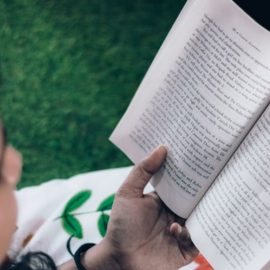

This article is an excerpt from the Shortform book guide to "Maid" by Stephanie Land. Shortform has the world's best summaries and analyses of books you should be reading.
Like this article? Sign up for a free trial here .
What are the main differences between Stephanie Land’s memoir Maid and its Netflix adaptation? How did the changes expand the story?
In her memoir Maid, Stephanie Land recalls the period of her life when she was working as a housekeeper and single-handedly providing for her daughter, all while living below the poverty line. In 2021, Netflix adapted the memoir into a miniseries starring Margaret Qualley, making significant changes to the overall story.
Here are the biggest changes Netflix’s Maid makes to Land’s book.
1. The Characters’ Names and Setting Changed
One of the first changes made to the show was changing the main characters’ names. This was done to distance the source material from the show, seeing that some storylines are expanded or changed for dramatic reasons. Below are the three biggest name changes:
- Stephanie Land becomes Alex
- Jamie (Land’s ex-boyfriend) becomes Sean
- Mia (Land’s daughter) becomes Maddy
In addition, while Land’s parents aren’t named in her memoir, they’re named Hank and Paula in the Netflix series. They have a much more significant presence in the show than they do in the book, which is why they were given names.
In addition to the characters’ names, the location also changed. Both the Netflix series and book take place in the state of Washington, only Land’s memoir recounts her time living and working in Port Townsend. In the show, Alex lives in Port Hampstead and has to take a ferry to clean houses on the fictional Fisher Island.
Netflix’s Maid doesn’t specify what year it takes place. But given that Alex goes on a Tinder date in the episode “Cashmere,” viewers can assume that it takes place in 2021, the year the show was released. Land’s memoir is set primarily in 2009 and instead of using Tinder, Land uses an online dating website.
2. The Central Theme Is Different
TITLE: Maid
AUTHOR: Stephanie Land
TIME: 14
READS: 24.1
IMG_URL: https://www.shortform.com/blog/wp-content/uploads/2022/06/maid-cover.png
BOOK_SUMMARYURL: maid-summary-stephanie-land
AMZN_ID: XYZ
Other than the changes in character names and setting, the biggest difference between Netflix’s Maid and the memoir is the central theme. In Land’s book, poverty is the main focus and issue in Land’s life. She discusses how she came from generations of poverty and lived below the poverty line after leaving her abusive boyfriend and becoming a part-time housekeeper and student. Furthermore, the novel touches on the social stigmas placed on those in poverty.
Both the series and memoir talk about the effects of domestic abuse, especially in terms of poverty. However, the Netflix series focuses more on how abuse destroys Alex’s life by giving Sean and her mother a bigger story. In both the series and memoir, Sean/Jamie abuses Land/Alex, but she never goes back to him in the memoir. In the show, Alex gives him a second chance but their relationship always ends in him verbally or physically abusing her.
Unlike the memoir, the show touches on generational abuse more than generational poverty. Alex recalls she and her mother escaping her childhood home because her father was physically abusing her mother. Nothing like this is stated in the memoir. This situation differs slightly in the memoir, in which her father abuses her stepmother. By changing this storyline, there’s another layer to Alex and her mother’s complicated relationship and shows that Alex is following in her mother’s footsteps.
However, despite this major difference, the show still puts great emphasis on Alex’s financial difficulties as a single working mother. Both Alex and Land rely on government assistance programs such as the SNAP food program and emergency government housing. Alex is concerned with other people’s judgments of her financial situation—such as when she uses SNAP benefits at the store or a friend discovers that she slept at a ferry terminal—but at the end of the day, the series is more concerned with Alex’s relationships.
3. The Netflix Series Gives Land’s Ex a Bigger Story
Because the show focuses more on the subject of domestic abuse, Land’s ex has a bigger story in the show. There are passing references in the book on the physical abuse and the bitter custody battle, but for the most part, Jamie’s main role in the book is taking Mia on the weekends while Land cleans houses.
The series, however, expands Jamie’s role—or Sean, as he’s known in the adaptation. Alex’s central conflict is her ongoing custody battle with Sean, in addition to her on-again, off-again relationship with him. The series also gives reasoning to Sean’s disturbing behavior—his struggle with alcoholism. Sean clearly wants to be a better father to Maddy, but his addiction always gets in the way of this. The show also makes a grave point that Sean comes from an abusive household, making him a product of his environment and contributing to the theme of generational abuse.
The book never states that Land got back together with Jamie while he was recovering (which Alex often did), but both of the stories do end on a hopeful note as Land/Alex head off to Missoula to attend college away from Jamie/Sean.
4. Land’s Mother Has a Bigger Role
In addition to Land’s love life expanding in the show, her relationship with her mother is also bigger. This, in part, might have to do with the fact that Margaret Qualley (Alex) and Andie MacDowell (Paula) are daughter and mother in real life.
Land’s mother is rarely mentioned in her memoir. She only mentions her upbringing, her mother moving to Europe with her new husband, and her mother sneering at her when Land can’t afford to pay a restaurant bill. But much like how Sean’s alcoholism takes a toll on Alex’s life in the show, Paula’s bipolar disorder adds another level of stress.
In the show, Paula is an eccentric, free-spirited artist who has a lot of love for her daughter but isn’t the support system Alex needs. Alex doesn’t trust her own mother to take care of herself, and the one time Paula babysat Maddy turns out disastrous. Paula is even too distracted to sign a declaration stating that Alex is a capable mother to Maddy, which would’ve helped her win the custody battle. In one of the most stressful moments of the show, Alex and Sean have to drive to Las Vegas to confront Paula’s new (and much younger) husband who lost all of Paula’s mortgage money by gambling. The heartbreaking confrontation causes Paula to have a breakdown, breaking into the family home, and severely cutting her wrists. These instances make Alex feel like she has to take care of her mother in addition to her daughter.
These difficulties are never an issue in the book. Land’s mother is merely just a woman who isn’t present in her life. In contrast, Paula is too big of a presence in Alex’s life, making it much more complicated than it needs to be.
5. Alex Stays in a Domestic Abuse Shelter, Land Stays in a Homeless Shelter
After witnessing her father abuse her stepmother, Land and Mia move into an emergency homeless shelter for 90 days. There she’s subjected to random urinalysis, unit inspections, and a curfew. When the 90 days are up, they move into transitional housing where most people come from homeless shelters or jail. Here the police, firefighters, and paramedics often check apartments to make sure they’re clean or if they’ve repaired broken-down cars in the parking lots. These constant check-ins make Land feel insecure about her financial situation because it promotes the stigma that poor people are untrustworthy and dirty. Land begins to feel unsafe and applies for government aid to live in an apartment.
In the show, Alex never stays in a homeless shelter. After leaving Sean, she applies for subsidized housing. However, the apartment begins to grow black mold and forces Alex and Maddy to move into several different places, including Hank’s house, Alex’s friend’s house, a client’s house on Fisher Island, and Sean’s trailer. After Sean throws a glass at Alex, she calls a client of hers who takes her and Maddy to an emergency shelter for victims of domestic abuse. There she begins to feel safe and cared for by other residents, who have been in similar situations as Alex.
6. The Clients Are More Important
Land’s memoir writes about the different people whose houses she cleaned, but she never dwells on them. Land recalls finding one house where a husband and wife lived completely different lives in separate rooms where the husband had porn magazines and the wife had romance novels. Seeing how unhappy these people are, despite them living in a large house with money, makes Land appreciate the relationship she has with Mia.
Almost every client Alex has in the Netflix show affects her personally. One client, in particular, wealthy corporate lawyer Regina, checks in on a depressed Alex when she didn’t show up for work. When Alex escapes Sean’s trailer, Regina drives her to the emergency shelter for domestic abuse victims. But their relationship didn’t start out so sweet. Alex resents Regina at first because Regina seems ungrateful for her luxurious life. Regina is also stuck-up, accuses Alex of being a drug addict, and gets Alex in trouble because she wasn’t satisfied with Alex’s cleaning job.
However, Alex learns that Regina has had multiple miscarriages, which led to the split with her husband James. Alex writes in her diary, “Confessions of a Maid,” that Regina seems lonely because “when you live in a house that big, you begin to lose yourself.” Regina finds her diary and is touched by how Alex articulated loneliness so well.
7. The Series Makes Alex’s World Bigger
Given that Maid is a memoir, it’s understandable that it only focuses on Land’s life. She rarely mentions her co-workers, other people in the homeless shelter, or her clients. The adaptation makes the world of Maid a little bigger by giving stories to Alex’s co-workers, the majority of whom are women of color. One of these supporting characters includes Danielle (played by a Dominican-American actress), who is staying at the domestic abuse shelter but ends up going back to her abusive boyfriend because she was struggling to work as a single mother.
Statistically, most housekeepers and abuse victims are women of color: 68% of house cleaners are women of color, with Latina women making up the highest percentage (59%). Women of color also experience significantly higher rates of domestic violence than white women. By adding more women of color in housekeeping jobs or as domestic abuse victims, the series is recognizing these statistics.
From her fellow housekeepers to the other residents in the domestic abuse shelter, there’s a more diverse set of characters to better represent how poverty and abuse affect women of color. The series also shines a light on people struggling with addiction and mental illness through Sean, Hank, Paula, and Alex’s storylines, which aren’t mentioned in the memoir.
However, the series is still from a white woman’s perspective and tells a white woman’s story. There’s a valid argument that Alex still has it much easier because she is white. The end of the series shows Alex receiving benefits such as housing and paid tuition through her MFA program. It’s a happy ending, completing her “rags to riches” story, but that’s not the reality for the supporting characters who are people of color. It’s highly likely that the story does have a happy ending because Alex is white. There’s a question if the story would have a different ending or take a little longer to receive a happy ending if Maid was told from a woman of color’s perspective.
Were the Changes Necessary?
The changes made for Netflix’s Maid are big, but the tone and central story is still the same. It’s still about a single mother’s struggle with poverty and how she overcame the odds. But including more stories from different perspectives made for a compelling and diverse story that even Stephanie Land approved of.
If you liked or disliked the changes that were included in the Maid TV show, leave a comment below and tell us what you think.

———End of Preview———
Like what you just read? Read the rest of the world's best book summary and analysis of Stephanie Land's "Maid" at Shortform .
Here's what you'll find in our full Maid summary :
- The true story of a single mother who struggled to make ends meet as a housekeeper
- A social commentary on the American “pull yourself up by your bootstraps” mentality
- Background information, research, and statistics on the key themes in the memoir






